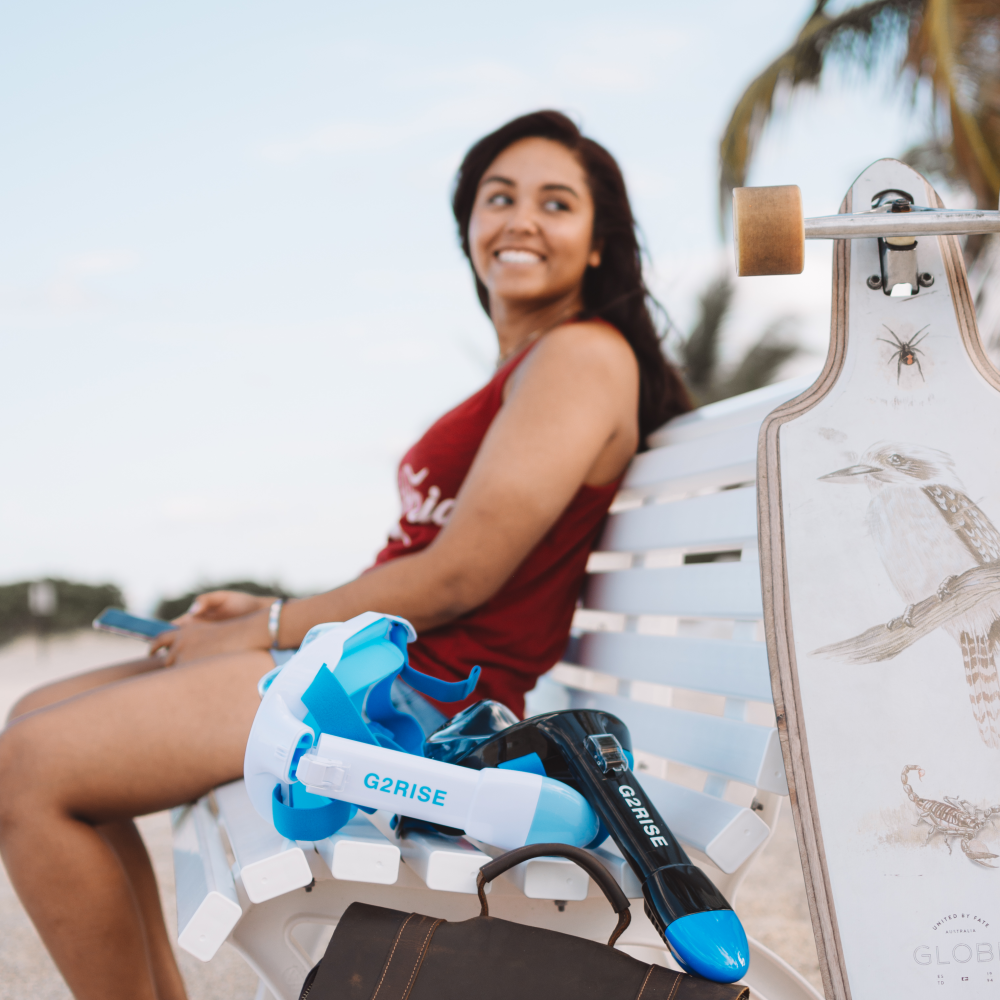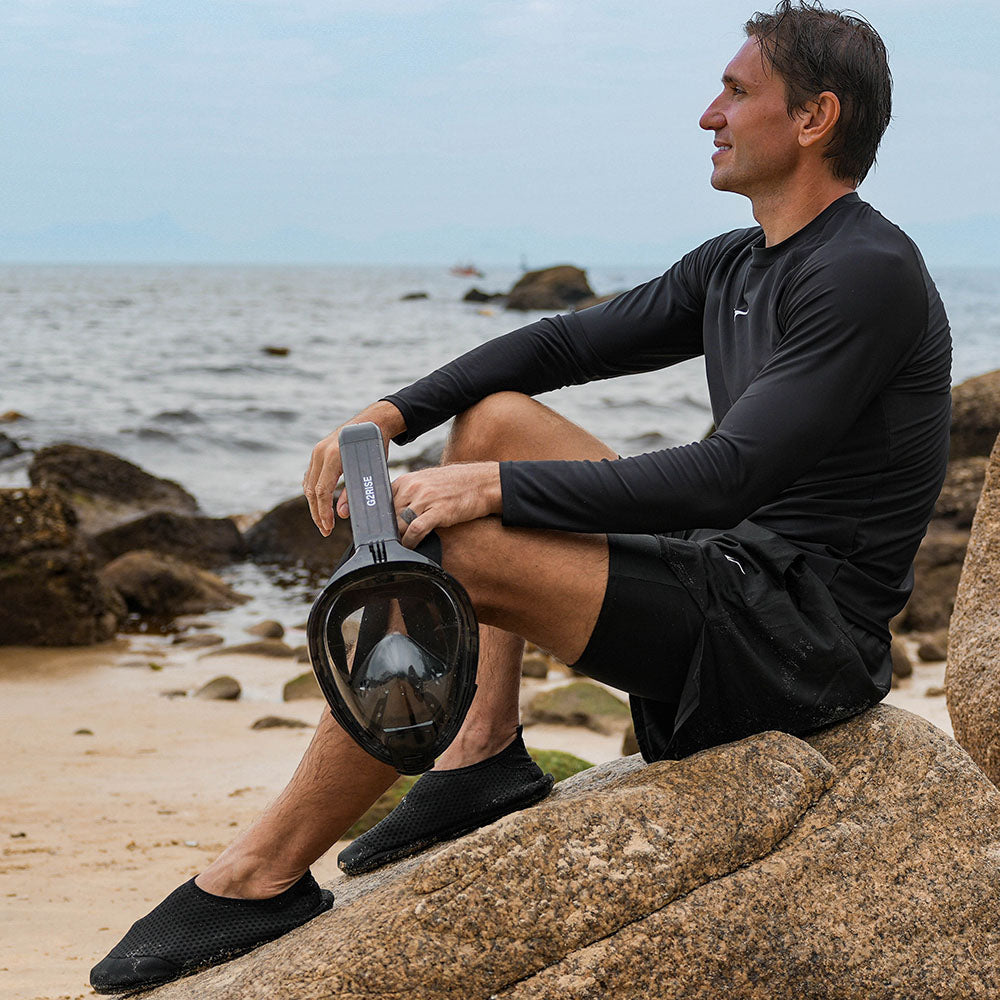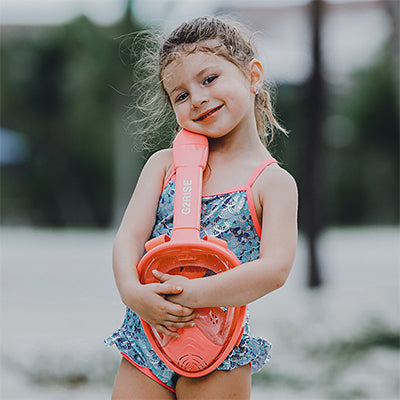Watching your kids discover what's under the water is one of the best parts of a beach vacation. Snorkeling isn't just fun—it helps children become better swimmers, builds their confidence, and gets them interested in ocean life. The key is starting them off right with gear that actually fits them and teaching techniques that work for their age. This guide covers everything you need: picking the right masks and snorkels, getting kids comfortable with the equipment, choosing good practice spots, and keeping everything safe.

1. Select the Right Snorkel Gear for Small Children (Ages 3-7)
Finding properly fitting equipment is your first step toward successful snorkeling with children. The right gear prevents frustration and keeps kids safe and comfortable.
Choose Junior-Sized Snorkels with Easy-Breathing Features
Children need smaller snorkels that match their lung capacity. Look for:
- Shorter tubes (12-14 inches) with narrower diameters
- Soft silicone mouthpieces are designed for smaller jaws
- Dry or semi-dry models that block water entry when submerged
A good children's snorkel reduces breathing effort and prevents panic when water enters the tube.
Test Masks for a Watertight Seal
The mask is often the most important piece of equipment. Without a proper seal, the experience quickly becomes miserable. For children's masks:
- Test the fit by having them inhale gently through their nose without using the strap
- Choose masks with soft silicone skirts that conform to smaller faces
- Consider frame size - many adult masks are too wide for children's faces
While full-face masks let kids breathe normally, traditional masks generally provide better visibility and are lighter.
Select Simple Starter Fins for Little Feet
Keep it simple with fins. Children need:
- Shorter, lighter designs that won't strain small leg muscles
- Closed-heel models for beginners (they're easier to put on)
- Enough room to grow, but not so much that they slip off
Finish with essentials like rash guards for sun protection and some form of flotation assistance while learning. More specific safety equipment will be covered in the safety section.
2. Practice Basic Snorkel Skills with Small Children at Home Before Beach Day
Small children need a gradual introduction to snorkeling before trying it at the beach. With some simple practice at home, they'll be much more comfortable when it's time for the real thing.
Introduce Gear Through Fun Games
Most young kids feel strange about putting masks and snorkels on their faces at first. Start by playing short games at home—try superhero masks or elephant trunk pretend play with the snorkel. Move to gentle practice in the bathtub once they're comfortable with how the equipment feels. If they seem nervous, take a break and try again later. Kids learn best when it feels like play, not a lesson.
Teach Simple Breathing Techniques
Breathing through a snorkel isn't natural for children. Begin with having them blow bubbles through a straw in a glass of water, then progress to the actual snorkel. Help them practice taking slow, steady breaths. Counting while they breathe ("in for 2, out for 2") helps establish a rhythm. Most kids need several short practice sessions before they get the hang of it.
Show How to Clear Water From the Tube
Even with a kid-friendly snorkel, some water might get in. Teach them to blow out hard, like blowing out birthday candles, to push water out of the tube. Show them how it works by demonstrating it first. Make it into a simple game rather than a technical skill. Also, show them how to simply take the snorkel out of their mouth if too much water gets in.
Create Simple Hand Signals
Since talking underwater isn't possible, teach a few basic hand signals. Keep them very simple: thumbs up for "I'm happy," a tap on your arm for "I need help," and pointing for "look at that fish." Practice these signals during your pretend ocean games at home. Remind kids they can stop anytime they want—knowing this helps them feel safer in the water.

3. Transition Children from Practice to Real Snorkeling
All your at-home practice pays off when you reach the actual snorkeling location, but remember that real water presents new challenges. Even with thorough preparation, children often need time to adjust to the real environment.
Start in Shallow, Calm Water
Begin in water where your child can easily stand with their head above the surface. Choose a protected cove, a roped-off swimming area, or even a pool for the first attempt. Have them wear all their gear, but start by just sitting in shallow water and putting their face in while holding their breath. Once comfortable, have them try breathing through the snorkel without swimming.
Teach Floating and Observation
Once breathing through the snorkel feels natural, teach your child to float with their face in the water. Hold them gently under their stomach if needed, gradually reducing support as they gain confidence. Encourage them to focus on interesting things to look at underwater—place colorful toys on the bottom in clear water, or point out sand patterns and small fish.
Introduce Basic Fin Movements
After they're comfortable floating face-down, demonstrate simple fin kicks. Show them how to keep their legs mostly straight and kick from the hips rather than the knees. For very young children, use the "mermaid kick" approach—keeping their feet together and moving them up and down together. Hold their hands and pull them gently while they practice.
Build Confidence Through Practice
Every child learns at their own pace. Some take to snorkeling immediately, while others need many short sessions to feel comfortable. Limit initial snorkel sessions to 10-15 minutes to prevent fatigue and cold. Always end before your child gets tired or uncomfortable, and praise specific accomplishments to build their confidence for the next session.
4. Prevent Common Snorkeling Accidents With Children
Safety concerns for child snorkelers differ from those for adults or general swimming. Focus on these snorkel-specific precautions to prevent the most common issues.
Check Equipment Before Each Use
Examine the snorkel tube for cracks that could allow unexpected water entry. Test that the mask strap hasn't weakened and that the mask skirt isn't torn. For younger children, dry snorkels can fail if the float valve sticks - test it by submerging before each session. Replace any damaged equipment immediately rather than trying to make it work.
Monitor Breathing Technique
Many child snorkeling incidents stem from improper breathing. Watch for signs of rapid or shallow breathing, which often precede panic. If your child starts holding their breath intermittently while snorkeling (common when children get excited), gently remind them to maintain steady breathing. Position yourself where you can see their snorkel tube clearing regularly.
Prevent Cold Water Shock
Children lose body heat much faster than adults while snorkeling because they remain relatively still in the water. Even in warm climates, limit sessions to 20-30 minutes and watch for shivering, blue lips, or sudden irritability. Have a towel and warm clothing ready immediately after they exit the water.
Recognize Pre-Panic Behaviors
Most children show specific signals before full panic: rapid head lifting, frequent snorkel clearing, grabbing at their mask, or making quick, jerky movements. When you spot these early warning signs, calmly help them stand or reach shallow water before panic escalates. After addressing the specific issue (water in the mask, fatigue, cold), they can often continue snorkeling.

5. Advance Children's Snorkeling Skills Step-by-Step
After mastering basic snorkeling skills, children can progress to more exciting underwater experiences. This sequential approach builds technical ability while maintaining safety.
Teach Proper Mask Clearing Techniques
Once comfortable with basic face submersion, teach children how to clear water from their mask without removing it. Start in shallow water where they can stand. Have them:
- Hold the top of their mask firmly against their forehead
- Look downward slightly
- Exhale gently through their nose while tilting their head back
Begin with tiny amounts of water in the mask. Most 5-7-year-olds can learn this skill with practice, while younger children may need to stick with the simpler approach of removing the mask entirely.
Introduce Surface Diving for Short Periods
When children demonstrate comfort with face-down floating, teach controlled submersion:
- Practice holding breath for 5-second counts while floating at the surface
- Demonstrate the dolphin-like motion of dipping below the surface while continuing to hold the snorkel
- Show how to clear the snorkel immediately upon resurfacing
- Begin with targets just 1-2 feet below the surface (colorful dive toys work well)
Surface diving develops breath control and builds confidence for exploring slightly deeper environments.
Practice Navigation and Orientation Skills
Many children become disoriented while focusing on underwater sights. Build spatial awareness through:
- Following a pre-set "underwater trail" marked by objects
- Looking up periodically to check the position relative to the shore
- Swimming in simple patterns (straight lines, gentle curves)
- Practicing how to tread water and adjust position without standing
These navigation exercises prepare children for slightly larger exploration areas as their skills improve.
Incorporate Marine Life Identification
Turn snorkeling sessions into educational experiences with age-appropriate identification activities:
- Bring waterproof fish identification cards for older children
- Set "scavenger hunts" for specific, common marine creatures
- Count particular types of fish or coral formations
- Practice the proper "look but don't touch" approach to marine conservation
These focused activities extend attention spans underwater while building knowledge that enhances the snorkeling experience.

Teach Your Child to Snorkel Step by Step!
Teaching small children to snorkel is rewarding when you follow the right process. Start with properly sized equipment that fits their faces and bodies. Practice at home first through games and bathtub sessions to build comfort with the gear. When ready for real water, begin in calm, shallow areas where they can stand. Always watch carefully for signs of discomfort and keep sessions short. As they gain confidence, gradually introduce new skills like mask clearing and simple surface dives.














Leave a comment
This site is protected by hCaptcha and the hCaptcha Privacy Policy and Terms of Service apply.